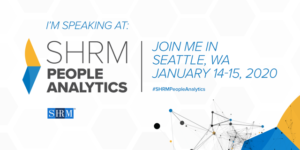People Analytics: How to Solve Business Problems

Every business has problems they want to
solve. It could be a small problem or a large one. The key to solving business problems
is
Gathering the right data and informationHaving a good approach or system for
problem solving
Unfortunately, there are times when organizations
approach problem solving from the standpoint of “Oh, I know what the problem
is…” and ultimately, end up only addressing a symptom versus the real issue.
I’m sure you’ve seen it too. One approach to make for better data gathering and
problem solving would be to use analytics. Here’s an overview of the four
analytics levels and how they could be applied to address a challenge many
organizations face: employee turnover.
DESCRIPTIVE analytics is focused on what’s happened. The first step in solving most problems is figuring out what’s took place – that’s descriptive analytics. The organization wants to collect information and data on the who, what, when, and where. The good news is with technology, you might be able to gather this information easily.
An example might be reviewing
exit interview data to see if there are any trends for
why employees are leaving, when they tender their resignation, and what
positions / departments the employees work in.
DIAGNOSTIC analytics answer the question “why did it happen?”. Using the information from step one (descriptive analytics), the organization might be able to reach some conclusions about the situation. A technology solution might provide some assistance is filtering the data in different ways to explore new causes and correlations.
For instance, the organization might discover
that managers tend to resign in March or April (right after they receive their
annual bonus). Or a large number of new hires are leaving the marketing department
within their introductory period. (Not making any judgements about marketing departments
here. It’s just an example.)
PREDICTIVE analytics is about what will happen. I like to think of this step as “How will the situation play out?” Meaning if the contributing factors don’t change, what will the situation look like. Or if only one factor is changed how will that impact the outcome.
Companies can’t and probably don’t want to
make lots of changes at one time. They want to implement change in a logical
manner and use their resources wisely. Using a phased approach can also help individuals
plan, accept, and embrace change.
PRESCRIPTIVE analytics points toward “What should we do?”. In the predictive analytics stage, the organization considers all of the options. In the prescriptive analytics phase, decisions are made.
Using our turnover and employee retention
situation, the organization might decide to focus on stay interviews. Managers
can ask a stay interview question during regular one-on-one meetings. HR might
add a stay interview question to new hire onboarding check-ins and regular
pulse surveys.
If you’re looking for more information about analytics, check out “Predictive Analytics for Human Resources”. I’m a big fan of Jac Fitz-enz and his work. You know that I recommend his book “How to Measure Human Resources Management” to everyone. His predictive analytics book is equally excellent.
Organizations can use the principles of
analytics to help them identify problems and brainstorm solutions using data as
the driving factor. This is definitely one of those moments when we can put the
power of technology to excellent use.

P.S. Don’t forget that the Society for Human
Resource Management (SHRM) is hosting their first People
Analytics Conference. It’s scheduled for January 14-15,
2020 in Seattle. HR Bartender readers can get 50% off the regular registration
rate using the code PA20SHARLYN. I’m planning to be there. Hope to
see you!!
The post People Analytics: How to Solve Business Problems appeared first on hr bartender.






Sharlyn J. Lauby's Blog
- Sharlyn J. Lauby's profile
- 10 followers



